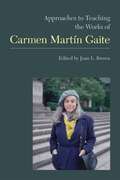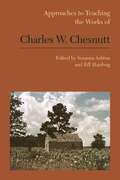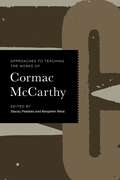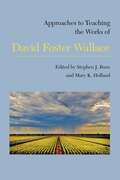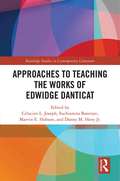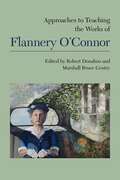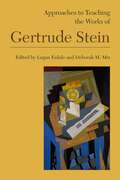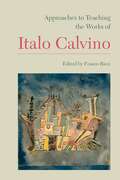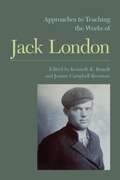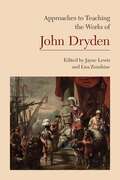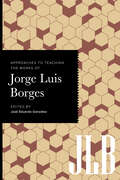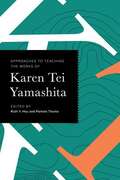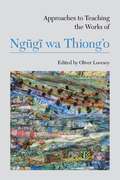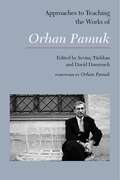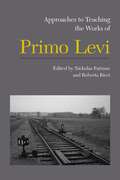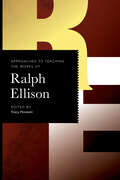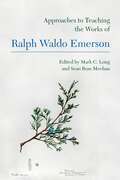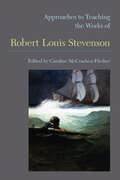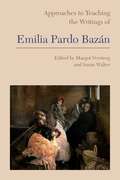- Table View
- List View
Approaches to Teaching the Works of Carmen Martín Gaite (Approaches to Teaching World Literature #128)
by Joan L. BrownThe career of Spain's celebrated author Carmen Martín Gaite spanned the Spanish Civil War, Franco's dictatorship, and the nation's transition to democracy. She wrote fiction, poetry, drama, screenplays for television and film, and books of literary and cultural analysis. The only person to win Spain's National Prize for Literature (Premio Nacional de las Letras) twice, Martín Gaite explored and blended a range of genres, from social realism to the fantastic, as she took up issues of gender, class, economics, and aesthetics in a time of political upheaval.Part 1 ("Materials") of this volume provides resources for instructors and a literary-historical chronology. The essays in part 2 ("Approaches") consider Martín Gaite's best-known novel, The Back Room (El cuarto de atrás), and other works from various perspectives: narratological, feminist, sociocultural, stylistic. In an appendix, the volume editor, who was a friend of the author, provides a new translation of Martín Gaite's only autobiographical sketch, alongside the original Spanish.
Approaches to Teaching the Works of Charles W. Chesnutt (Approaches to Teaching World Literature #149)
by Susanna Ashton and Bill HardwigGrowing up in Cleveland after the Civil War and during the brutal rollback of Reconstruction and the onset of Jim Crow, Charles W. Chesnutt could have passed as white but chose to identify himself as black. An intellectual and activist involved with the NAACP who engaged in debate with Booker T. Washington and W. E. B. Du Bois, he wrote fiction and essays that addressed issues as various as segregation, class among both blacks and whites, Southern nostalgia, and the Wilmington coup d'état of 1898. The portrayals of race, racial violence, and stereotyping in Chesnutt's works challenge teachers and students to contend with literature as both a social and an ethical practice.In part 1 of this volume, "Materials," the editors survey the critical reception of Chesnutt's works in his lifetime and after, along with the biographical, critical, and archival texts available to teachers and students. The essays in part 2, "Approaches," address such topics in teaching Chesnutt as his use of dialect, the role of intertextuality and genre in his writing, irony, and his treatment of race, economics, and social justice.
Approaches to Teaching the Works of Christine de Pizan (Approaches to Teaching World Literature #148)
by Andrea TarnowskiA prolific poet and a protofeminist, Christine de Pizan worked within a sophisticated late medieval court culture and formed an identity as an authority on her society's preoccupations with religion, politics, and morality. Her works address various aspects of misogyny, the appropriate actions of rulers, and the ethical framework for social conduct. In addition to gaining a readership in fifteenth-century France, Christine's works influenced writers in Tudor England and were identified by twentieth-century readers as important contributions both to the emergence of a professional literary class and to the intellectual climate that gave rise to early modern Europe.Part 1 of this volume, "Materials," surveys the editions in Middle French, translations into modern French and English, and the many scholarly resources and critical reactions of the past fifty years. Part 2, "Approaches," provides insights into various aspects of Christine's works that can be explored with students, from considerations of genre and form to the themes of virtue, history, and memory. Teachers of French, English, world literature, and women's studies will find useful ideas throughout the volume.
Approaches to Teaching the Works of Cormac McCarthy (Approaches to Teaching World Literature #167)
by Stacey Peebles Benjamin WestIn the decades since his 1992 breakout novel, All the Pretty Horses, Cormac McCarthy has gained a reputation as one of the greatest contemporary American authors. Experimenting with genres such as the crime thriller, the post-apocalyptic novel, and the western, his work also engages with the aesthetics of cinema, and several of his novels have been adapted for the screen. While timely and relevant, his works use idiosyncratic language and contain intense, troubling portrayals of racism, sexism, and violence that can pose challenges for students.This volume offers strategies for guiding students through McCarthy's oeuvre, addressing all his novels as well as his published plays and screenplays. Part 1, "Materials," provides sources of biographical information and key scholarship on McCarthy. Essays in part 2, "Approaches," discuss subjects such as landscape and ecology, mythologies of the American West, film adaptations, and literary contexts and describe assignments that encourage students to write creatively and to examine their personal values.
Approaches to Teaching the Works of David Foster Wallace (Approaches to Teaching World Literature #156)
by Stephen J. Burn and Mary K. HollandDavid Foster Wallace's works engage with his literary moment--roughly summarized as postmodernism--and with the author's historical context. From his famously complex fiction to essays critical of American culture, Wallace's works have at their core essential human concerns such as self-understanding, connecting with others, ethical behavior, and finding meaning. The essays in this volume suggest ways to elucidate Wallace's philosophical and literary preoccupations for today's students, who continue to contend with urgent issues, both personal and political, through reading literature.Part 1, "Materials," offers guidance on biographical, contextual, and archival sources and critical responses to Wallace's writing. The essays in part 2, "Approaches," discuss teaching key works and genres in high school settings, first-year undergraduate writing classes, American literature surveys, seminars on Wallace, and world literature courses. They examine Wallace's social and philosophical contexts and contributions, treating topics such as gender, literary ethics, and the culture of writing programs.
Approaches to Teaching the Works of Edwidge Danticat (Routledge Studies in Contemporary Literature)
by Celucien L. Joseph Suchismita Banerjee Marvin E. Hobson Danny M. Hoey Jr.Providing an intellectual interpretation to the work of Edwidge Danticat, this new edited collection provides a pedagogical approach to teach and interpret her body of work in undergraduate and graduate classrooms. Approaches to Teaching the Works of Edwidge Danticat starts out by exploring diasporic categories and postcolonial themes such as gender constructs, cultural nationalism, cultural and communal identity, and moves to investigate Danticat’s human rights activism, the immigrant experience, the relationship between the particular and the universal, and the violence of hegemony and imperialism in relationship with society, family, and community. The Editors of the collection have carefully compiled works that show how Danticat’s writings may help in building more compassionate and relational human communities that are grounded on the imperative of human dignity, respect, inclusion, and peace.
Approaches to Teaching the Works of Eliza Haywood (Approaches to Teaching World Literature #162)
by Tiffany PotterDuring her long and varied career, Eliza Haywood acted onstage, worked as a publisher and bookseller, and wrote prolifically in many genres, from novels of seduction to essays in periodicals. Her works illuminate the private emotional lives of people in eighteenth-century England, invite readers to consider how women in that culture defined themselves and criticized oppression, and help us better understand the social debates of the period.This volume addresses a broad range of Haywood's works, providing literary and sociopolitical context from writings by Aphra Behn, Samuel Richardson, Samuel Johnson, and others, and from contemporary documents such as advice manuals and court records. The first section, "Materials," identifies high-quality editions, reliable biographical sources, and useful background information. The second section, "Approaches," suggests ways to help students engage with Haywood's work, gain a nuanced understanding of the time period, work with primary documents, and participate in digital humanities projects.
Approaches to Teaching the Works of Eliza Haywood (Approaches to Teaching World Literature #162)
by Tiffany PotterDuring her long and varied career, Eliza Haywood acted onstage, worked as a publisher and bookseller, and wrote prolifically in many genres, from novels of seduction to essays in periodicals. Her works illuminate the private emotional lives of people in eighteenth-century England, invite readers to consider how women in that culture defined themselves and criticized oppression, and help us better understand the social debates of the period.This volume addresses a broad range of Haywood's works, providing literary and sociopolitical context from writings by Aphra Behn, Samuel Richardson, Samuel Johnson, and others, and from contemporary documents such as advice manuals and court records. The first section, "Materials," identifies high-quality editions, reliable biographical sources, and useful background information. The second section, "Approaches," suggests ways to help students engage with Haywood's work, gain a nuanced understanding of the time period, work with primary documents, and participate in digital humanities projects.
Approaches to Teaching the Works of Flannery O'Connor (Approaches to Teaching World Literature #158)
by Robert Donahoo Marshall Bruce GentryKnown for her violent, startling stories that culminate in moments of grace, Flannery O'Connor depicted the postwar segregated South from a unique perspective. This volume proposes strategies for introducing students to her Roman Catholic aesthetic, which draws on concepts such as incarnation and original sin, and offers alternative contexts for reading her work.Part 1, "Materials," describes resources that provide a grounding in O'Connor's work and life. The essays in part 2, "Approaches," discuss her beliefs about writing and her distinctive approach to fiction and religion; introduce fresh perspectives, including those of race, class, gender, and interdisciplinary approaches; highlight her craft as a creative writer; and suggest pairings of her works with other texts. Alice Walker's short story "Convergence" is included as an appendix.
Approaches to Teaching the Works of Gertrude Stein (Approaches to Teaching World Literature #152)
by Logan Esdale and Deborah M. MixA trailblazing modernist, Gertrude Stein studied psychology at Radcliffe with William James and went on to train as a medical doctor before coming out as a lesbian and moving to Paris, where she collected contemporary art and wrote poetry, novels, and libretti. Known as a writer's writer, she has influenced every generation of American writers since her death in 1946 and remains avant-garde.Part 1 of this volume, "Materials," provides information and resources that will help teachers and students begin and pursue their study of Stein. The essays of part 2, "Approaches," introduce major topics to be covered in the classroom--race, gender, feminism, sexuality, narrative form, identity, and Stein's experimentation with genre--in a wide range of contexts, including literary analysis, art history, first-year composition, and cultural studies.
Approaches to Teaching the Works of Inca Garcilaso de la Vega (Approaches to Teaching World Literature #169)
by Christian Fernández and José Antonio MazzottiThe author of Comentarios reales and La Florida del Inca, now recognized as key foundational works of Latin American literature and historiography, Inca Garcilaso de la Vega was born in 1539 in Cuzco, the son of a Spanish conquistador and an Incan princess, and later moved to Spain. Recalling the family stories and myths he had heard from his Quechua-speaking relatives during his youth and gathering information from friends who had remained in Peru, he created works that have come to indelibly shape our understanding of Incan history and administration. He also articulated a new American identity, which he called mestizo.This volume provides guidance on the translations of Garcilaso's writings and on the scholarly reception of his ideas. Instructors will discover ideas for teaching Garcilaso's works in relation to indigenous thought, European historiography, natural history, indigenous religion and Christianity, and Incan material culture. In essays informed by postcolonial and decolonial perspectives, scholars draw connections between Garcilaso's writings and contemporary issues like migration, multiculturalism, and indigenous rights.
Approaches to Teaching the Works of Italo Calvino (Approaches to Teaching World Literature #125)
by The Modern Language Association of AmericaItalo Calvino, whose works reflect the major literary and cultural trends of the second half of the twentieth century, is known for his imagination, humor, and technical virtuosity. He explores topics such as neorealism, folktale, fantasy, and social and political allegory and experiments with narrative style and structure. Students take delight in Calvino's wide-ranging and inventive work, whether in Italian courses or in courses in comparative or world literature, literary criticism, cultural studies, philosophy, or even architecture.Given the range of his writing, teaching Calvino can seem a daunting task. This volume aims to help instructors develop creative and engaging classroom strategies. Part 1, "Materials," presents an overview of Calvino's writings, nearly all of which are available in English translation, as well as critical works and online resources. The essays in part 2, "Approaches," focus on general themes and cultural contexts, address theoretical issues, and provide practical classroom applications. Contributors describe strategies for teaching Calvino that are as varied as his writings, whether having students study narrative theory through If on a winter's night a traveler, explore literary genre with Cosmicomics, improve their writing using Six Memos for the Next Millennium, or read Mr. Palomar in a general education humanities course.
Approaches to Teaching the Works of Jack London (Approaches to Teaching World Literature #132)
by Jeanne Campbell ReesmanA prolific and enduringly popular author--and an icon of American fiction--Jack London is a rewarding choice for inclusion in classrooms from middle school to graduate programs. London's biography and the role played by celebrity have garnered considerable attention, but the breadth of his personal experiences and political views and the many historical and cultural contexts that shaped his work are key to gaining a nuanced view of London's corpus of works, as this volume's wide-ranging perspectives and examples attest.The first section of this volume, "Materials," surveys the many resources available for teaching London, including editions of his works, sources for his photography, and audiovisual aids. In part 2, "Approaches," contributors recommend practices for teaching London's works through the lenses of socialism and class, race, gender, ecocriticism and animal studies, theories of evolution, legal theory, and regional history, both in frequently taught texts such as The Call of the Wild, "To Build a Fire," and Martin Eden and in his lesser-known works.
Approaches to Teaching the Works of John Dryden (Approaches to Teaching World Literature #126)
by The Modern Language AssociationWhich John Dryden should be brought into the twenty-first-century college classroom? The rehabilitator of the ancients? The first of the moderns? The ambivalent laureate? The sidelined convert to Rome? The literary theorist? The translator? The playwright? The poet? This volume in the MLA series Approaches to Teaching World Literature addresses the tensions, contradictions, and versatility of a writer who, in the words of Samuel Johnson, "found [English poetry] brick, and left it marble," who was, in the words of Walter Scott, "one of the greatest of our masters."Part 1, "Materials," offers a guide to the teaching editions of Dryden's work and a discussion of the background resources, from biographies and literary criticism to social, cultural, political, and art histories. In part 2, "Approaches," essays describe different pedagogical entries into Dryden and his time. These approaches cover subjects as various as genre, adaptation, literary rivalry, musical setting, and political and religious poetry in classroom situations that range from the traditional survey to learning through performance.
Approaches to Teaching the Works of Jorge Luis Borges (Approaches to Teaching World Literature #180)
by José Eduardo GonzálezOften considered a writer who transcends national borders, Jorge Luis Borges also aimed to reinvent the history and traditions of his own country, Argentina. His unconventional works appeal to students, who nonetheless can find his richly intertextual prose challenging. Addressing courses in Spanish and in English, this volume offers innovative approaches that help students navigate the texts, engage with them emotionally and creatively, and understand the time and place of their production while connecting them to the present.Part 1, "Materials," provides detailed biographical information about Borges as well as print and digital resources. The essays in part 2, "Approaches," offer strategies for discussing his writing process, his manuscripts, and the material history and translation of his texts. Contributors also examine Borges's influences, which include film, mythology, history, and ideas of Islam and Judaism; the author's interest in humor and games; and resonances with other literary works.
Approaches to Teaching the Works of Karen Tei Yamashita (Approaches to Teaching World Literature #168)
by Ruth Y. Hsu and Pamela ThomaStructurally innovative and culturally expansive, the works of Karen Tei Yamashita invite readers to rethink conventional paradigms of genres and national traditions. Her novels, plays, and other texts refashion forms like the immigrant tale, the postmodern novel, magical realism, apocalyptic literature, and the picaresque and suggest new transnational, hemispheric, and global frameworks for interpreting Asian American literature.Addressing courses in American studies, contemporary fiction, environmental humanities, and literary theory, the essays in this volume are written by undergraduate and graduate instructors from across the United States and around the globe. Part 1, "Materials," outlines Yamashita's novels and other texts, key works of criticism and theory, and resources for Asian American and Asian Brazilian literature and culture. Part 2, "Approaches," provides options for exploring Yamashita's works through teaching historical debates, outlining principles of environmental justice, mapping geographic boundaries to highlight power dynamics, and drawing personal connections to the texts. Additionally, an essay by Yamashita describes her own approaches to teaching creative writing.
Approaches to Teaching the Works of Miguel de Unamuno (Approaches to Teaching World Literature #164)
by Luis Álvarez-CastroA central figure of Spanish culture and an author in many genres, Miguel de Unamuno (1864-1936) is less well known outside Spain. He was a surprising writer and thinker: a professor of Greek who embraced metafiction and modernist methods, a proponent of Castilian Spanish although born in the Basque Country and influenced by many international writers, and an early existentialist who was yet religious. He found himself in opposition to both King Alfonso XIII and the military dictatorship of Miguel Primo de Rivera and then became involved in the political upheaval that led to the Spanish Civil War.Part 1 of this volume, "Materials," gives information on different editions and translations of Unamuno's works, on scholarly and critical secondary sources, and on Web resources. The essays in part 2, "Approaches," offer suggestions for introducing students to the range of his works--novels, essays, poetry, and drama--in Spanish language and literature, comparative literature, religion, and philosophy classrooms.
Approaches to Teaching the Works of Ngũgĩ wa Thiong'o (Approaches to Teaching World Literature #121)
by Oliver LoveseyNgũgĩ wa Thiong'o is one of the most important and celebrated authors of postindependence Africa as well as a groundbreaking postcolonial theorist. His work, written first in English, then in Gikuyu, engages with the transformations of his native Kenya after what is often termed the Mau Mau rebellion. It also gives voice to the struggles of all Africans against economic injustice and political oppression. His writing and activism have continued despite imprisonment, the threat of assassination, and exile.Part 1 of this volume, "Materials," provides resources and background for the teaching of Ngũgĩ's novels, plays, memoirs, and criticism. The essays of part 2, "Approaches," consider the influence of Frantz Fanon, Karl Marx, and Joseph Conrad on Ngũgĩ; how the role of women in his fiction is inflected by feminism; his interpretation and political use of African history; his experimentation with orality and allegory in narrative; and the different challenges of teaching Ngũgĩ in classrooms in the United States, Europe, and Africa.
Approaches to Teaching the Works of Octavia E. Butler (Approaches To Teaching World Literature Ser. #160)
by Tarshia L. StanleyOctavia E. Butler's works of science fiction invite readers to consider the structures of power in society and to ask what it means to be human. Butler addresses social justice issues such as poverty, racism, and violence against women and connects the history of slavery in the United States with speculation on a biologically altered future world.The first section of this volume, "Materials," lists secondary sources and interviews with Butler and suggests texts that instructors might pair with her works. Essays in the second section, "Approaches," situate Butler in science fiction, modernism, and Afrofuturism and provide interdisciplinary approaches from political science, philosophy, art, and digital humanities. The contributors present strategies for teaching Butler in literature courses as well as courses designed for adult learners, preservice teachers, and students at historically black colleges and universities.
Approaches to Teaching the Works of Orhan Pamuk (Approaches to Teaching World Literature #146)
by Sevinç Türkkan and David DamroschWinner of the Nobel Prize in Literature in 2006, Orhan Pamuk is Turkey's preeminent novelist and an internationally recognized figure of letters. Influenced by both Turkish and European literature, his works interrogate problems of modernity and of East and West in the Turkish context and incorporate the Ottoman legacy linguistically and thematically. The stylistic and thematic aspects of his novels, his intriguing use of intertextual elements, and his characters' metatextual commentaries make his work rewarding in courses on world literature and on the postmodern novel. Pamuk's nonfiction writings extend his themes of memory, loss, personal and political histories, and the craft of the novel.Part 1, "Materials," provides biographical background and introduces instructors to translations and critical scholarship that will elucidate Pamuk's works. In part 2, "Approaches," essays cover topics that support teachers in a range of classrooms, including Pamuk's use of the Turkish language, the political background to Pamuk's novels, the politics of translation and aesthetics, and Pamuk's works as world literature.
Approaches to Teaching the Works of Primo Levi (Approaches to Teaching World Literature #133)
by Nicholas Patruno Roberta RicciPrimo Levi, Holocaust survivor and renowned memoirist, is one of the most widely read writers of post-World War II Italy. His works are characterized by the lean, dispassionate eloquence with which he approaches his experience of incarceration in Auschwitz. His memoirs--as well as his poetry and fiction and his many interviews--are often taught in several fields, including Jewish studies and Holocaust studies, comparative literature, and Italian language and literature, and can enrich the study of history, psychology, and philosophy.The first part of this volume provides instructors with an overview of the available editions, anthologies, and translations of Levi's work and identifies other useful classroom aids, such as films, music, and online resources. In the second part, contributors describe different approaches to teaching Levi's work. Some, in presenting Survival in Auschwitz, The Reawakening, and The Drowned and the Saved, look at the place of style in Holocaust testimony and the reliability of memory in autobiography. Others focus on questions of translation, complicated by the untranslatable in the language and experiences of the concentration camps, or on how Levi incorporates his background as a chemist into his writing, most clearly in The Periodic Table.
Approaches to Teaching the Works of Ralph Ellison (Approaches to Teaching World Literature #177)
by Tracy FloreaniOne of the most important American authors and public intellectuals of the twentieth century, Ralph Ellison had a keen and unsentimental understanding of the relationship between race, art, and activism in American life. He contended with other writers of his day in his examination of the entrenched racism in society, and his writing continues to inform national conversations in letters and culture.The essays in Approaches to Teaching the Works of Ralph Ellison will help instructors in colleges, high schools, and prisons teach not only the indispensable Invisible Man but also Ellison's short stories, his essays, and the two editions of his second, unfinished novel, Juneteenth and Three Days before the Shooting . . . . In considering Ellison's works in relation to jazz, technology, humor, politics, queerness, and disability, this volume mirrors the breadth of Ellison's own life, which extended from the Jim Crow era through the Black Power movement.
Approaches to Teaching the Works of Ralph Waldo Emerson (Approaches to Teaching World Literature #155)
by Mark C. Long and Sean Ross MeehanA leader of the transcendentalist movement and one of the country's first public intellectuals, Ralph Waldo Emerson has been a long-standing presence in American literature courses. Today he is remembered for his essays, but in the nineteenth century he was also known as a poet and orator who engaged with issues such as religion, nature, education, and abolition.This volume presents strategies for placing Emerson in the context of his time, for illuminating his rhetorical techniques, and for tracing his influence into the present day and around the world. Part 1, "Materials," offers guidance for selecting classroom editions and information on Emerson's life, contexts, and reception. Part 2, "Approaches," provides suggestions for teaching Emerson's works in a variety of courses, not only literature but also creative writing, religion, digital humanities, media studies, and environmental studies. The essays in this section address Emerson's most frequently anthologized works, such as Nature and "Self-Reliance," along with other texts including sermons, lectures, journals, and poems.
Approaches to Teaching the Works of Robert Louis Stevenson (Approaches to Teaching World Literature #124)
by Caroline McCracken-FlesherAlthough Robert Louis Stevenson was a late Victorian, his work--especially Treasure Island and The Strange Case of Dr. Jekyll and Mr. Hyde--still circulates energetically and internationally among popular and academic audiences and among young and old. Admired by Henry James, Vladimir Nabokov, and Jorge Luis Borges, Stevenson's fiction crosses the boundaries of genre and challenges narrow definitions of the modern and the postmodern.Part 1 of this volume, "Materials," provides an introduction to the writer's life, a survey of the criticism of his work, and a variety of resources for the instructor. In part 2, "Approaches," thirty essays address such topics as Stevenson's dialogue with James about literature; his verse for children; his Scottish heritage; his wanderlust; his work as gothic fiction, as science fiction, as detective fiction; his critique of imperialism in the South Seas; his usefulness in the creative writing classroom; and how Stevenson encourages expansive thinking across texts, times, places, and lives.
Approaches to Teaching the Writings of Emilia Pardo Bazán (Approaches to Teaching World Literature #147)
by Margot Versteeg Susan Walter"Emilia Pardo Bazán (1851-1921) was the most prolific and influential woman writer of late nineteenth-century Spain," write the editors of this volume in the MLA's Approaches to Teaching World Literature series. Contending with the critical literary, cultural, and social issues of the period, Pardo Bazán's novels, novellas, short stories, essays, plays, travel writing, and cookbooks offer instructors countless opportunities to engage with a variety of critical frameworks. The wide range of topics in the author's works, from fashion to science and technology to gender equality, and the brilliance of her literary style make Pardo Bazán a compelling figure in the classroom.Part 1, "Materials," provides biographical and critical resources, an overview of Pardo Bazán's vast and diverse oeuvre, and a literary-historical time line. It also reviews secondary sources, editions and translations, and digital resources. The twenty-three essays in part 2, "Approaches," explore various issues that are central to teaching Pardo Bazán's works, including the author's engagement with contemporary literary movements, feminism and gender, nation and the late Spanish empire, Spanish and Galician identities, and nineteenth-century scientific and medical discourses. Film adaptations and translations of Pardo Bazán's works are also addressed. Highlighting the artistic, social, and intellectual currents of Pardo Bazán's writings, this volume will assist instructors who wish to teach the author's works in courses on world literature, nineteenth-century literature, and gender studies as well as in Spanish-language courses.
